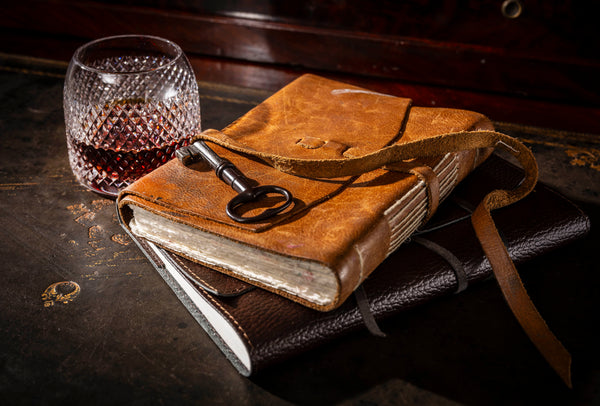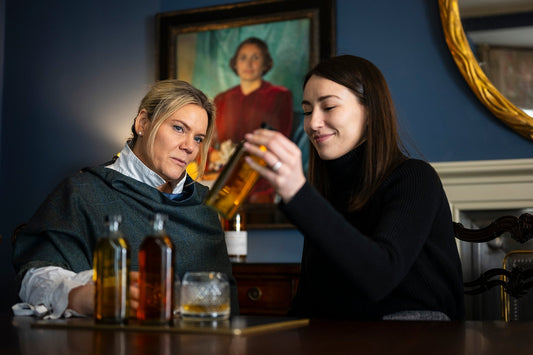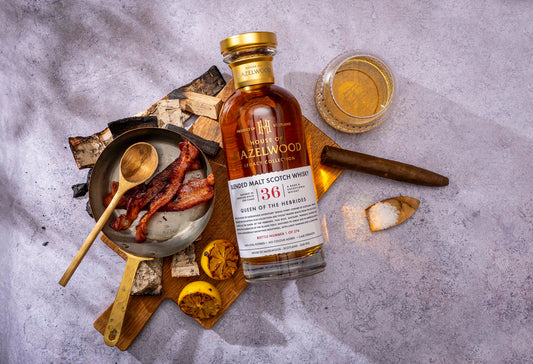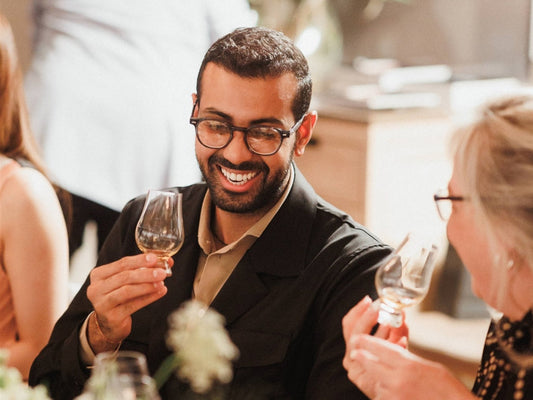A fine rare Scotch whisky is so much more than a rewarding drinking experience.
These treasured bottles form a link between the land, its people, and the purpose of the community behind the drop.
While everyday “casual” whisky found in the supermarkets has its place, for many of us it is the search for authenticity, a real link between the past and present, that provides the most fulfilment. And, as such, learning how to distinguish a rare Scotch from the rest is fundamental.
So, what should you look out for when purchasing a bottle of rare Scotch Whisky, and what are the real hallmarks of quality?

Rare Scotch Checklist: Provenance
A key hallmark of quality is the whisky’s provenance.
The location, climate, and environment where the barley is grown, the water sourced for distilling, local traditions, and the casks used for maturation all play an important role in shaping the final flavour profile of a whisky.
By learning about the specific region, distillery, and age of a whisky, we are offered insight into the unique methodology and characteristics of the spirit.
Often, established distilleries will have long-standing traditions and techniques that have been honed over generations, ensuring consistency and quality in each batch - and what better marker of quality than… well, proof of it?
Ultimately, by exploring a rare whisky’s provenance we can form a better picture of the origins and craft behind the bottle, and thus make a more informed decision about its quality.
This is also where the exceptional whiskies set themselves apart – with unique histories or particular cultural relevance.
When it comes to provenance, there’s probably no better example in our inventory than A Singular Blend.
This whisky is composed not only of whiskies from the same region but of Scotch whiskies from the very same Highland distillery – with both grain and malt components stemming from the same year of production at the same site.
After 58 years of maturation in American oak, the blend has acquired a wealth of intricate flavours that harmonise with and elevate every aspect of the distillery's character.
On the nose we’re greeted by a delightful butterscotch sweetness with a subtle suggestion of the scent of saddlery workshops. On the palate, the whisky presents a perfectly balanced interplay of sweet and sour flavours, punctuated by hints of waxy fruit skin.
This remarkable, distinctive release is a testament to the exceptional complexity that can arise from a solitary distillery – and with just 74 bottles ever released – one of the rarest whiskies money can buy.

Rare Scotch Checklist: Scarcity
In addition to the factors considered, when purchasing a rare Scotch whisky, those which are truly rare will naturally be limited in numbers, with hundreds or merely tens of bottles available. The number of bottles available will be subject to each expression: for instance, those which are highly aged and prolific in their history are likely to be in short supply.
Our 1965 Blended Scotch Whisky, Blended at Birth, is a fine example of the special status certain bottles can elevate to.
This rare whisky, of which only 192 bottles exist, combines malt and grain components that were both distilled as New Make spirit in 1965. This term (New Make) refers to the high-proof, unaged, and colourless spirit produced during the first distillation of the mash. Nowadays, Scotch Whisky law dictates that this New Make spirit must mature in oak casks for three years before blending. However, in the case of Blended at Birth, the malt and grain spirits were combined before aging, resulting in a unified blend that has matured together for 56 years in ex-bourbon American oak casks.
This technique has produced a remarkable blend where the texture, flavours, and structure of the spirit are seamlessly interwoven. On the nose, tropical fruits and floral scents swell and combine, while the palate is rich with a luscious, sweet texture and notes of caramel and fudge. The experience culminates in an indulgent, fragrant crispness, leading to a dry and tart finish.
Not only is this an exceptional whisky in both character and provenance but the fact that this production technique is no longer permitted under Scotch Whisky law promotes this bottle to a class of its own when it comes to rarity and scarcity – the unique combination of flavours and complex layers can never be reproduced, imitated, or recreated ever again.
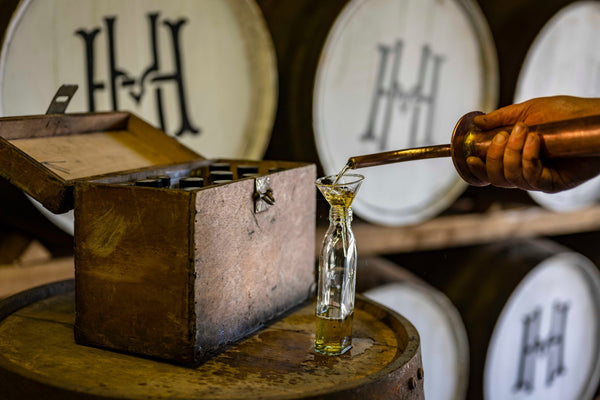
Rare Scotch Checklist - Authenticity
One aspect to look out for when purchasing a bottle of rare Scotch whisky is the level of intervention that has been made as part of the bottling process.
These largely fall under three categories:
Chill Filtration
Chill filtration is a process used by some whisky producers to remove haziness or cloudiness in their whisky, which is caused by certain compounds becoming cloudy at lower temperatures.
The aim here is to ensure a more consistent, clearer opacity – most likely to give the impression of ‘purity’.
Some hold the view that the process of chill filtration strips a whisky of the natural oils and fats present – which in theory could affect the final flavour and texture of the spirit. The reality is that there is no consensus on this – and there’s little scientific evidence to suggest that chill filtration detracts from the final whisky.
In contrast, non-chill filtered whisky is argued to retain all these natural compounds, resulting in a richer, more complex flavour profile and a creamier mouthfeel.
But buyer beware – the use of chill filtration does not always mean an inferior product – some whiskies require minimal chill filtration to ensure the stability of a product. Instead of using chill filtration as a hallmark of quality, instead consider the production methodology of the producer. A tell-tale sign of a great whisky is when it hails from a producer who doesn’t shy away from the technique - if it is fundamentally important in retaining integrity, then bottling for quality is all that matters. Instead look for producers who aim to minimise intervention where possible – as the distiller intended.
Added Colours
Artificial colouring could be misleading when added to a Scotch Whisky.
Added colours can give the false impression that the whisky is older or of higher quality than it actually is. For example, a whisky producer producing at scale may be known to use colouring to make their younger whiskies appear darker and more consistent in presentation, or to suggest flavour imparted from casks which would be impossible over a shorter period of time. This masks the whisky’s true character and deprives us of valuable information we can draw from the spirit’s natural colour.
The colour of a real high-quality whisky should not need to be altered – with its unique profile adding to its appeal. Try to steer clear of added colour when dealing with premium whiskies – although caramel colouring (e150a) does not impact flavour, it might be prone to telling a fib or two about maturation.
Strength
Whisky is distilled at a high strength and then diluted with water to reach the desired bottling strength, at a minimum of 40% alcohol by volume (ABV).
When it comes to this strength, higher alcohol content does not necessarily mean a better quality whisky – and similarly, if bottled near the legal minimum of 40%, does not mean it is an inferior liquid.
Higher strength whiskies may be harder to find when dealing with rare Scotch Whisky. Rare Scotch is typically aged for decades at a time, and as a consequence, natural evaporation – known as the Angel’s Share – can dilute the strength of the whisky over many years – coming out at a strength more commonly seen with mainstream whiskies.
Whiskies that are dubbed “small batch” or “cask strength” are often safe bets for quality. This means they have been handled with considerable care, in a craft-focused environment (as opposed to a factory-style environment) and are a representation of the distiller’s intentions. They have been bottled when they are ready – not according to market demand.
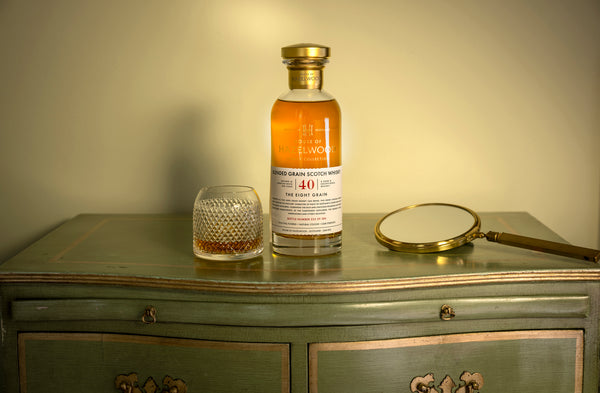
As the Distiller Intended
Our Blended Grain Whisky, The Eight Grain, is a great example of the sophistication offered by a natural, non-chill filtered, cask strength Scotch.
Combining component spirits from eight of Scotland’s closed and active grain whisky distilleries, The Eight Grain celebrates the unfiltered character of each to form a wonderfully unified Scotch.
This whisky’s extensive aging period of 40 years is further testament to its quality and nuanced complexity.
A multi-faceted, enticing blend of baked sugar, caramelised banana, and banoffee pie is first detectable on the nose, supported by a refined background of wood shavings. The palate is rounded and balanced – allowing us to fully enjoy the character of fleshy stone fruits which emerge above the classically creamy, generous aged grain whisky character.
This is a pure representation of the finest grain whisky, without the need for dilution, colourant, or chill filtration – and with only 384 bottles in circulation, a standout rare whisky for even the most experienced of enthusiasts.
Rare Scotch: Spotting the Hallmarks of Quality
By following our checklist above, focusing on the production methods of a whisky, its provenance, and whether it holds ‘special’ status, you can be sure to improve your chances of discovering true rarity and quality.
As ever, the importance here is to enjoy the process of discovery and learning. One whisky may lead to another. Or a specific region may hold a particular place in your heart.
Ultimately, whisky revolves around the personal connections we can build with a spirit.
And so, equipped with new-found knowledge, browse our range of high-quality whiskies here and find your next special bottle.
